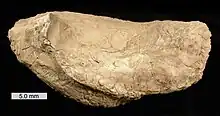| Crassostrea Temporal range: | |
|---|---|
_Top_(16114506758).jpg.webp) | |
| Eastern oyster (Crassostrea virginica) | |
| Scientific classification | |
| Domain: | Eukaryota |
| Kingdom: | Animalia |
| Phylum: | Mollusca |
| Class: | Bivalvia |
| Order: | Ostreida |
| Family: | Ostreidae |
| Genus: | Crassostrea Sacco, 1897[1] |
| Species | |
|
See text | |
| Synonyms | |
| |
Crassostrea is a genus of true oysters (family Ostreidae) containing some of the most important oysters used for food. Some species in the genus have been moved to the genus Magallana.
Species
Extant species
Extant species include:[2]
- Crassostrea aequatorialis (d'Orbigny 1846)[2]
- Crassostrea angulata (Lamarck 1819) – Portuguese oyster
- Crassostrea brasiliana (Lamarck 1819)[2]
- Crassostrea chilensis (Philippi 1845)
- Crassostrea columbiensis (Hanley 1846)[2]
- Crassostrea corteziensis (Hertlein 1951)
- Crassostrea cuttackensis (Newton & Smith, 1912)
- Crassostrea dianbaiensis (Xia, Wu, Xiao & Yu, 2014)
- Crassostrea rhizophorae (Guilding 1828)[2]
- Crassostrea sikamea (Amemiya 1928) – Kumamoto oyster
- Crassostrea tulipa (Lamarck 1819) – mangrove oyster[2]
- Crassostrea virginica (Gmelin 1791) – eastern oyster[2]
Fossil species

Crassostrea gigantissima (Finch, 1824) right valve interior (Eocene of Texas).
Fossil species include:[3]
- †Crassostrea alabamiensis (Lea 1833)
- †Crassostrea ashleyi (Hertlein 1943) (syn. Ostrea arnoldi)
- †Crassostrea cahobasensis (Pilsbry and Brown 1910)
- †Crassostrea contracta (Conrad 1865)
- †Crassostrea cucullaris (Lamarck 1819)
- †Crassostrea cuebana (Jung 1974)
- †Crassostrea elegans (Deshayes, 1832)[4] (syn. †Cubitostrea elegans Deshayes 1832 or Crassostrea (Cubitostrea) elegans)
- †Crassostrea gigantissima (Finch 1824) – Giant fossil oyster
- †Crassostrea gryphoides (Schlotheim 1813)
- †Crassostrea hatcheri (Ihering 1899)
- †Crassostrea ingens (Zittel 1864)
- †Crassostrea kawauchidensis (Tamura 1977)
- †Crassostrea patagonica (d'Orbigny 1842) (syn. Ostrea ferrarisi)
- †Crassostrea raincourti (Deshayes 1858)
- †Crassostrea titan (Conrad 1853) (syn. Ostrea prior, O. andersoni)
- †Crassostrea transitoria (Hupé 1854) (syn. Ostrea maxima)
- †Crassostrea wyomingensis[5]
Genetics
The genome of Crassostrea gigas (now Magallana gigas) has been recently sequenced revealing an extensive set of genes that enable it to cope with environmental stresses.[6]
References
- ↑ I Molluschi dei terreni terziari del Piemonte e della Liguria. F Sacco, 1897
- 1 2 3 4 5 6 7 Taxon list for Crassostrea. World Register of Marine Species, accessed on 9 August 2017.
- ↑ "†Crassostrea Sacco 1897". Paleobiology Database. Fossilworks. Retrieved 17 December 2021.
- ↑ irmng
- ↑ J. Haffty, R. G. Schmidt, L. B. Riley, W. D. Goss. Rocks and Mineral Resources of the Wolf Creek Area, Lewis and Clark and Cascade Counties, Montana: A Descriptive Report on an Area in the Disturbed Belt Along the Eastern Front of the Northern Rocky Mountains in Western Montana, Issues 1441-1446
- ↑ Zhang, G.; Fang, X.; Guo, X.; Li, L.; Luo, R.; Xu, F.; Yang, P.; Zhang, L.; Wang, X.; Qi, H.; Xiong, Z.; Que, H.; Xie, Y.; Holland, P. W. H.; Paps, J.; Zhu, Y.; Wu, F.; Chen, Y.; Wang, J.; Peng, C.; Meng, J.; Yang, L.; Liu, J.; Wen, B.; Zhang, N.; Huang, Z.; Zhu, Q.; Feng, Y.; Mount, A.; Hedgecock, D. (2012). "The oyster genome reveals stress adaptation and complexity of shell formation". Nature. 490 (7418): 49–54. Bibcode:2012Natur.490...49Z. doi:10.1038/nature11413. hdl:10722/251007. PMID 22992520.
This article is issued from Wikipedia. The text is licensed under Creative Commons - Attribution - Sharealike. Additional terms may apply for the media files.
.JPG.webp)